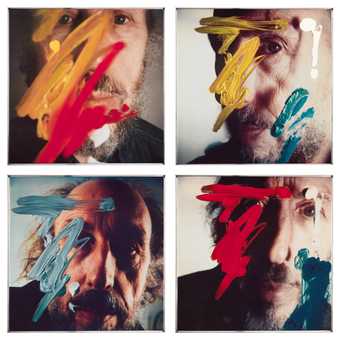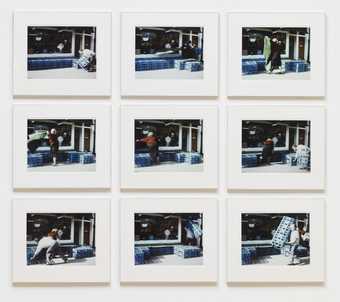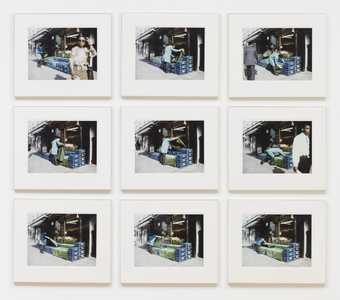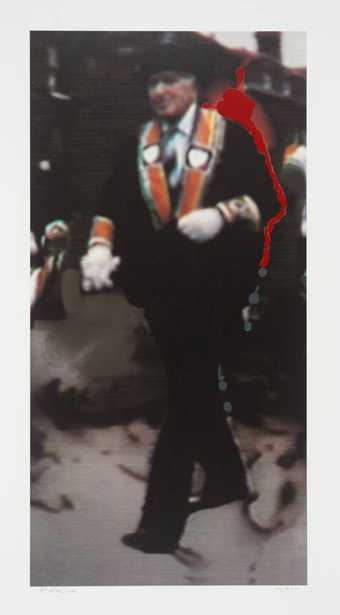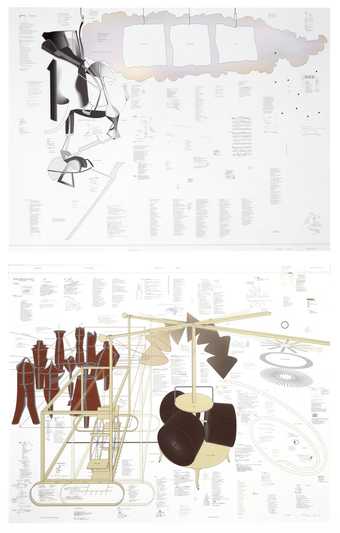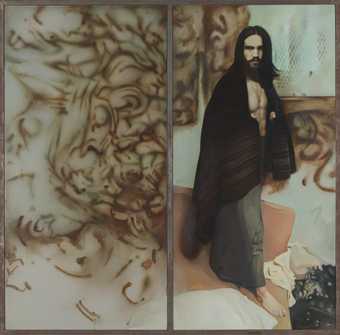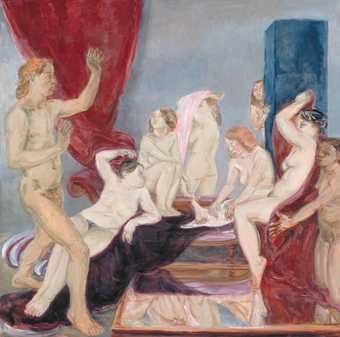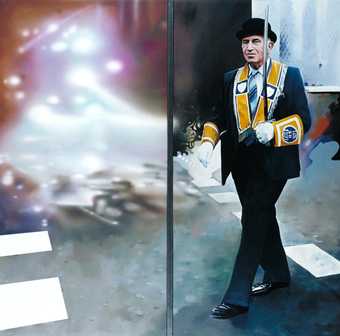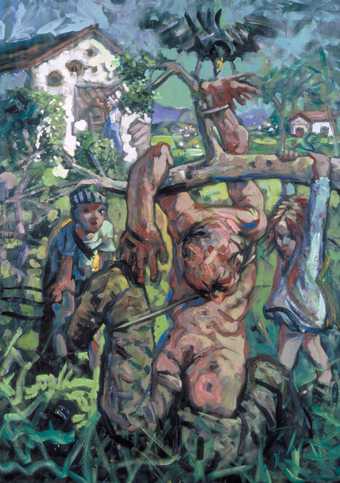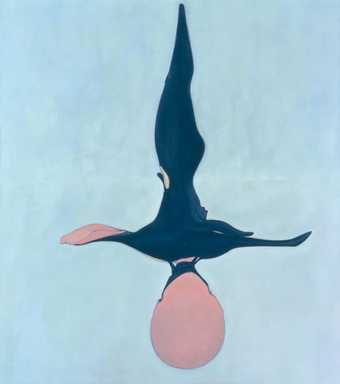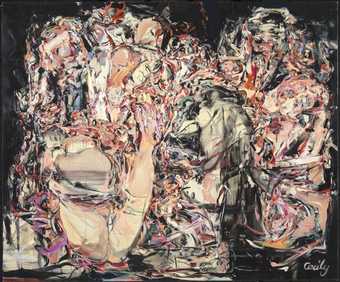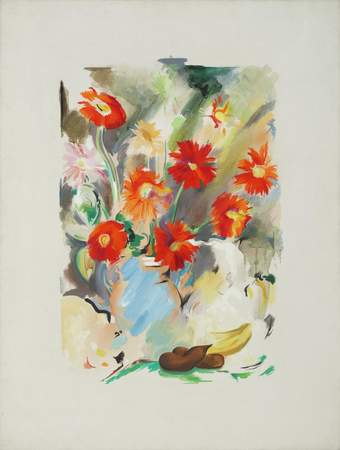
In Tate Liverpool
Democracies
Free- Artist
- Richard Hamilton 1922–2011
- Medium
- Oil paint, enamel paint and fabric on 2 photographs, dye destruction prints mounted on canvas
- Dimensions
- Support (1): 2000 × 1000 mm
support (2): 2000 × 1000 mm - Collection
- Tate
- Acquisition
- Purchased 1993
- Reference
- T06775
Summary
Hamilton has made three diptych paintings relating to the 'troubles' in Northern Ireland. The citizen, 1981-3 (Tate Gallery T03980), depicts a blanketman, a republican detainee at the Maze Prison. Blanketmen, in protest at their non-political status, refused to wear prison-issue clothing or obey prison regulations, and lived in their own squalor. The subject, 1988-90, (Tate Gallery T06774), represents a parading loyalist Orangeman. The state, 1993, shows a British soldier on patrol in Northern Ireland.
The state, Hamilton's image of the patrolling British soldier, expresses the unease of the army's equivocal position between the two warring groups in Northern Ireland, and the dual role the soldiers must play. The soldier is at once gun-wielding and defensive. Hamilton wanted to create the effect, in this picture, of the soldier walking backwards. It is a customary practice for British soldiers patrolling in Northern Ireland to walk back to back, some 100 yards apart, to ensure that they are covered in both directions. This idea also relates to the artist's perception that the British wish to get out of Northern Ireland. He represents the soldier as young and reluctant, a 'conscript'. Before Hamilton's birth, his father served in the British army during an earlier phase of the Irish troubles and conveyed to his son a sense of the warmth of the Irish people.
Hamilton's image of the British 'Tommy', who is seen against an urban background, recalls both the machine-filled street of the 'abstract' left-hand panel of The subject and, in the wriggling patterns of the camouflage battle dress, the curvilinear configurations in the equivalent panel in The citizen. On a signboard behind the soldier is the legend 'Spuds', the English vernacular for the potato, a vegetable particularly associated with Ireland. The word is also used by Cockney Londoners to refer to Irish people. The left-hand 'abstract' panel of The state is the rural Irish landscape, evoking an alternative setting for the British troops which is no less threatening than that of the city in the right-hand panel.
Hamilton's use of trompe l'oeil in the treatment of the battle dress reflects the ambiguity of the soldier's situation. Parts of the fabric are painted, while others are actual fabric laid on the picture surface. The camouflage markings applied to his face heighten his uneasy expression, joining with his clothes and visored helmet to link this painting with its two companion pictures in a theme common to many of Hamilton's works, that of the roles of costume and artifice in the presentation of the human image.
Further reading:
Carnegie
International 1991, exhibition catalogue, Carnegie Museum of Art, Pittsburgh 1991, pp.82-3Richard Morphet (ed.), Richard Hamilton, exhibition catalogue, Tate Gallery, London 1992, pp.176-7, 179-80
Terry Riggs
December 1997
Does this text contain inaccurate information or language that you feel we should improve or change? We would like to hear from you.
Display caption
Hamilton’s image of a patrolling British soldier expresses the unease of the army’s equivocal position in Northern Ireland. Brandishing a weapon, yet moving protectively backwards, he is both on the offensive and defensive. The rural Irish landscape and city streets behind him pose equal threats. Hamilton has incorporated real fabric into the soldier’s fatigues, merging pictorial representation and reality. The construction of images through costume and artifice has been a consistent concern in Hamilton's works.
Gallery label, November 2006
Does this text contain inaccurate information or language that you feel we should improve or change? We would like to hear from you.
Explore
- architecture(30,960)
-
- townscapes / man-made features(21,603)
- emotions and human qualities(5,345)
-
- fear(262)
- blur(210)
- photographic(4,673)
- politics and society(2,337)
- clothing and personal items(5,879)
-
- visor(14)
- gun, rifle(201)
- countries and continents(17,390)
-
- Ireland(315)
- Ireland, Ulster(203)
- Northern Ireland(202)
- transport: land(2,189)
-
- car(502)
You might like
-
Richard Hamilton Four Self Portraits - 05.3.81
1990 -
Michael Landy CBE RA Appropriation 3
1990 -
Michael Landy CBE RA Appropriation 4
1990 -
Richard Hamilton The Orangeman
1990 -
Richard Hamilton Typo/Topography of Marcel Duchamp’s Large Glass
2003 -
Richard Hamilton The citizen
1981–3 -
John Lessore Diana and Actaeon at the Byam Shaw
1987 -
Richard Hamilton The subject
1988–90 -
Peter Howson Plum Grove
1994 -
Stephen McKenna Large Studio at Castiglion
1993 -
Nicola Tyson Swimmer
1995 -
Cecily Brown Trouble in Paradise
1999 -
Richard Hamilton Bathers II
1964 -
Richard Hamilton The Saensbury Wing
1999–2000 -
Richard Hamilton Flower-piece II
1973

